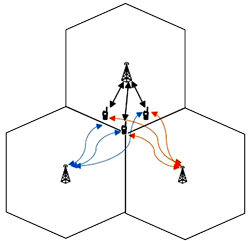System performance of three cell network with corner users using precoding, interference alignment and quantized limited channel feedback
DOI:
https://doi.org/10.3103/S0735272722070020Abstract
Users in the common corner of a three-cell downlink multi-user MIMO system suffer from low signal strength from their own cell as well as equal strength interference signal from their neighbour two cells. The schemes for interference mitigation are adopted to improve system sum-rate performance in this scenario. Further, the full CSI feedback by users to their base station puts high burden on the reverse feedback channel. Quantized reduced channel information feedback with interference alignment technique and suitable precoding can reduce the burden on the reverse channel as well as they can improve the system sum-rates. The LTE code book based precoding techniques provide improvements in the sum-rate. We design precoding using singular value decomposition (SVD) on the selected code vectors based on maximization of Equivalent Channel-Code vector (SVD-ECC) and maximization of SINR-Code vector (SVD-SINRC). Both these techniques show system sum-rate improvement over ZF based precoding technique, SVD-ECC providing more improvements than SVD-SINRC. We also experiment with users with orthogonal equivalent channels and the subsequent SVD on the selected users channel (SVD-ORT). We show results varying user SNR, number of selected user K and the total number of active user L in a cell.
References
Q. H. Spencer, C. B. Peel, A. L. Swindlehurst, M. Haardt, “An introduction to the multi-user MIMO downlink,” IEEE Commun. Mag., vol. 42, no. 10, pp. 60–67, 2004, doi: https://doi.org/10.1109/MCOM.2004.1341262.
Y. Zhu, Y. Ou, “Interference alignment-based precoding and user selection with limited feedback in two-cell downlink multi-user MIMO systems,” J. Eng. Sci. Technol. Rev., vol. 9, no. 2, pp. 115–120, 2016, doi: https://doi.org/10.25103/jestr.092.19.
A. Bayesteh, A. Mobasher, Y. Jia, “Downlink multi-user interference alignment in two-cell scenario,” in 2011 12th Canadian Workshop on Information Theory, 2011, pp. 182–185, doi: https://doi.org/10.1109/CWIT.2011.5872152.
G. Sridharan, W. Yu, “Degrees of freedom achieved using subspace alignment chains for three-cell networks,” in 2013 Asilomar Conference on Signals, Systems and Computers, 2013, pp. 1869–1874, doi: https://doi.org/10.1109/ACSSC.2013.6810627.
T. Liu, C. Yang, “On the degrees of freedom of asymmetric MIMO interference broadcast channels,” in 2014 IEEE International Conference on Communications (ICC), 2014, pp. 1971–1976, doi: https://doi.org/10.1109/ICC.2014.6883612.
A. D. Borah, M. A. Hussain, J. Bora, “Performance analysis of interference alignment-based precoding,” in Lecture Notes in Electrical Engineering, Singapore: Springer, 2020, pp. 919–927.
L. Zhang, L. Gui, X. Mo, M. Qi, “Interference subspace alignment-based precoding design for multi-cell multi-user systems,” IEEE Trans. Broadcast., vol. 67, no. 1, pp. 106–118, 2021, doi: https://doi.org/10.1109/TBC.2020.3028344.
J. Sheng, Z. Tang, Q. Zhu, C. Wu, Y. Wang, B. Ai, “An improved interference alignment algorithm with user mobility prediction for high-speed railway wireless communication networks,” IEEE Access, vol. 8, pp. 80468–80479, 2020, doi: https://doi.org/10.1109/ACCESS.2020.2989802.
= [4]
= [5]
C. Suh, M. Ho, D. N. C. Tse, “Downlink interference alignment,” IEEE Trans. Commun., vol. 59, no. 9, pp. 2616–2626, 2011, doi: https://doi.org/10.1109/TCOMM.2011.070511.100313.
W. Shin, N. Lee, J.-B. Lim, C. Shin, K. Jang, “On the design of interference alignment scheme for two-cell MIMO interfering broadcast channels,” IEEE Trans. Wirel. Commun., vol. 10, no. 2, pp. 437–442, 2011, doi: https://doi.org/10.1109/TWC.2011.120810.101097.
J. Tang, S. Lambotharan, “Interference alignment techniques for MIMO multi-cell interfering broadcast channels,” IEEE Trans. Commun., vol. 61, no. 1, pp. 164–175, 2013, doi: https://doi.org/10.1109/TCOMM.2012.100912.110644.
S. Peng, W. Lu, L. Zhong, Z. Kong, “Spatial interference alignment relying on limited precoding matrix feedback indices,” in 2020 IEEE 91st Vehicular Technology Conference (VTC2020-Spring), 2020, vol. 2020-May, pp. 1–5, doi: https://doi.org/10.1109/VTC2020-Spring48590.2020.9129168.
T. Yoo, N. Jindal, A. Goldsmith, “Finite-rate feedback MIMO broadcast channels with a large number of users,” in 2006 IEEE International Symposium on Information Theory, 2006, pp. 1214–1218, doi: https://doi.org/10.1109/ISIT.2006.261998.
N. Jindal, “Antenna combining for the MIMO downlink channel,” IEEE Trans. Wirel. Commun., vol. 7, no. 10, pp. 3834–3844, 2008, doi: https://doi.org/10.1109/T-WC.2008.070383.
R. Hajjar, R. V. Vissakodeti, “Codebook Based Multi-User MIMO for 5G,” Lund University, 2019.
3GPP, “Evolved Universal Terrestrial Radio Access (E-UTRA); Physical channels and modulation (3GPP TS 36.211 version 10.3.0 Release 10),” in Technical Specification, ETSI, 2011.


